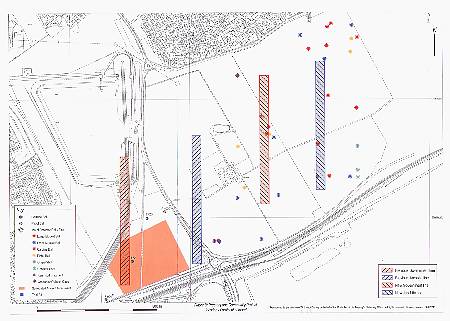On Finding Musket Balls from 1745 ...... at Seton East Farm ...
Battle Trust's Archaeological Survey 'Final Report' Published
It took a year longer than originally planned, but with the help of a Heritage Lottery Grant and its own volunteer resources, the Battle Trust has now completed its archaeological survey for the battle fought at Prestonpans on September 21st 1745. The work was carried out by one of Scotland's best-known international battle archaeologists, Dr Tony Pollard of Glasgow University, with senior colleague Natasha Ferguson.
Their full report is LINKED DIRECTLY HERE
Where precisely did the battle take place?
Folklore and myth for the past two centuries have it that the the Highlanders charged across the Waggonway to attack the Hanoverian Government's redcoats to the west of the track. However, the archaeological evidence collected and now reported indicates that the scene of the engagement was farther to the east, at Seton East Farm [the red and blue lines to the right being the proper location]. The scatter of musket balls, grape shot and pistol balls [ shown as * ] all point to a clear delineation of where the battle lines actually stood. It is shown here below and be sure to
CLICK ON THE MAP ITSELF TO ENLARGE:
this map appears as p.27 of the Full Report linked above

The identification of the battle lines in this precise way is of great significance to our community. Historic Scotland for the Scottish Government has just begun the process of formalising a 'national battlefields inventory'. That 'inventory' area will in future have much greater protection against development so that what is in fact a war cemetry as well as a field of honour can be conserved as the nation's heritage.
How long did the battle last?
The Trust has already explored the time of day at which the battle took place [LINKED HERE]. The identification of where the two opposing lines stood at Seton East Farm on September 21st also gives a significant clue to the duration of the battle.
It is a well established fact that after the initial encounter the redcoats quickly fled, dragoons first then the foot soldiers. The latter however were hemmed in by the walls of Preston House and were slaughtered at the foot of those walls. Colonel Gardiner was mortally wounded beneath the legendary thorn tree which was not felled until the early 1930s and of which the location is exactly known.
For foot soldiers to have fled as far as the walls of Preston House from positions to the east of the Waggonway would have taken more than the apocraphal 9 minutes often quoted. The verdict the Trust had arrived at earlier, that the battle lasted about an hour, is accordingly strongly supported. If there was indeed one phase that lasted just 9 or 10 minutes, it would have been the time the redcoats stood facing the charge giving forth their one and only volley of musket fire, with their cannons also firing and the Camerons pausing momentarily as they received that fire - on their southern [left] flank.
Archaeological Study is the fourth 'strategic' component of the Trust's Campaign for a Living History Battle Centre in the Pans
This excellent report from Dr Tony Polard and Natasha Ferguson provides the fourth strategic component which the Trust resolved to address in 2006. [Final Reports of all these studies, and more, are accessible at this website via the CAMPAIGN button on the left hand margin above of this page.]
1. The first was Max Gaunt's RGA study of the 'visitor potential' of such a Living History Centre which identified an economically viable, sustainable, facility could be achieved;
2. Next was haleysharpedesign's splendidly creative 'visitor experience' for the interior including Walking the Riggonhead Defile;
3. Third was the structural engineering evaluation of the BattleBing as a possible location and other options;
4. Fourth is this archaeological study; and
5. Fifth, about to burst onto our consciousness, is the phantasmagoric Prestonpans Tapestry, all 102 metres, embroidering for the nation what is already one of the 'great Scottish folk stories' - the Prince's campaign from Eriskay to Victory at Prestonpans [or more precisely now, Seton East!].
Published Date: April 20th 2010
|





